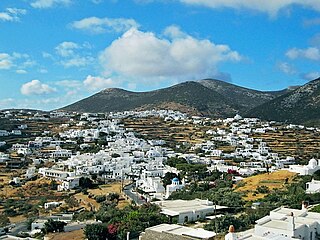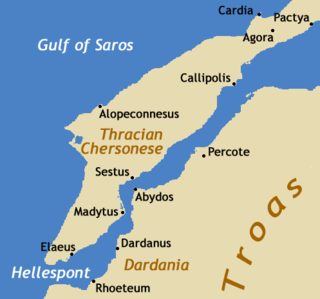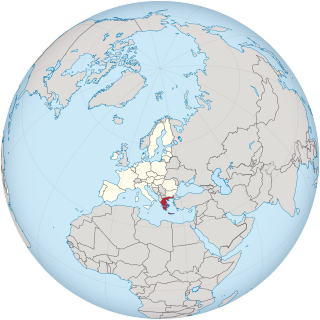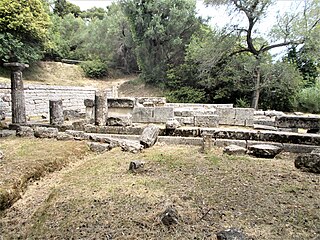
Delphi, in legend previously called Pytho (Πυθώ), was an ancient sacred precinct and the seat of Pythia, the major oracle who was consulted about important decisions throughout the ancient classical world. The ancient Greeks considered the centre of the world to be in Delphi, marked by the stone monument known as the omphalos (navel).

Naxos is a Greek island and the largest of the Cyclades. It was the centre of archaic Cycladic culture. The island is famous as a source of emery, a rock rich in corundum, which until modern times was one of the best abrasives available.

Thasos or Thassos is a Greek island in the North Aegean Sea. It is the northernmost major Greek island, and 12th largest by area.

Ionic Greek was a subdialect of the Attic–Ionic or Eastern dialect group of Ancient Greek.
Richard Chandler was an English antiquary.

Sifnos is an island municipality in the Cyclades island group in Greece. The main town, near the center, known as Apollonia, is home of the island's folklore museum and library. The town's name is thought to come from an ancient temple of Apollo on the site of the church of Panayia Yeraniofora. The second-largest town is Artemonas, thought to be named after an ancient temple of Apollo's sister-goddess Artemis, located at the site of the church of Panayia Kokhi. The village of Kastro, was the capital of the island during ancient times until 1836. It is built on top of a high cliff on the island's east shore and today has extensive medieval remains and is the location of the island's archeological museum. The port settlement, on the west coast of the island is known as Kamares.

Amorgos is the easternmost island of the Cyclades island group and the nearest island to the neighboring Dodecanese island group in Greece. Along with 16 neighboring islets, the largest of which is Nikouria Island, it comprises the municipality of Amorgos, which has a land area of 126.346 square kilometres and a population of 1,973.

The Choragic Monument of Lysicrates near the Acropolis of Athens was erected by the choregos Lysicrates, a wealthy patron of musical performances in the Theater of Dionysus, to commemorate the prize in the dithyramb contest of the City Dionysia in 335/334 BCE, of which performance he was liturgist.

The Society of Dilettanti is a British society of noblemen and scholars that sponsors the study of ancient Greek and Roman art, and the creation of new work in the style.

Elaeus, the “Olive City”, was an ancient Greek city located in Thrace, on the Thracian Chersonese. Elaeus was located at the southern end of the Hellespont near the southernmost point of the Thracian Chersonese in modern-day Turkey. According to the geographer Scymnus, Elaeus was founded by settlers from Ionian Teos, while the Pseudo-Scymnus writes that it was a colony of Athens and was founded by Phorbas

Nicholas Revett (1720–1804) was a British architect. Revett is best known for his work with James "Athenian" Stuart documenting the ruins of ancient Athens. He is sometimes described as an amateur architect, but he played an important role in the revival of Greek architecture.

The Serpent Column, also known as the Serpentine Column, Plataean Tripod or Delphi Tripod, is an ancient bronze column at the Hippodrome of Constantinople in what is now Istanbul, Turkey. It is part of an ancient Greek sacrificial tripod, originally in Delphi and relocated to Constantinople by Constantine the Great in 324. It was built to commemorate the Greeks who fought and defeated the Persian Empire at the Battle of Plataea. The serpent heads of the 8-metre (26 ft) high column remained intact until the end of the 17th century.

This page list topics related to Greece.

William Pars was an English watercolour portrait and landscape painter, draughtsman, and illustrator.

Sir George Wheler was an English clergyman and travel writer.

The Gymnasium at Delphi is a building complex of the 4th century BC at Delphi, Greece, which comprised the xystus and the palaestra, along with its auxiliary buildings such as the changing rooms and baths. It was situated between the Sanctuary of Athena Pronaia and the fountain Castalia. Some remains of archaic buildings, discovered under the xystus, were possibly related to a sanctuary dedicated to Demeter and indicate the sanctity of the area from earlier times.
Archaeological investigation in Delphi started in the second half of the 19th century, but it was not until 1892 when a systematic excavation began under the direction of Théophile Homolle and the French Archaeological School of Athens. The "Great Excavation" lasted 10 years and was concluded by the creation of the first museum on-site. In the years to follow, the site never ceased to be excavated and investigated. Several of the monuments were restored and new interpretations continue to see the light in the academic field.

The modern town of Delphi is situated immediately west of the archaeological site of the same name. The town was created as a home for the population of Castro, which was relocated to allow for the excavation of the site of ancient Delphi. The importance of the twin locations grew to the point where Delphi has also been made the name of the modern-day municipality, which includes the communities of the Plaistos valley system as far south as the Gulf of Corinth. The name Delphi came from the Oracle of Delphi, which was anciently accepted as a purveyor of truth revealed by the god Apollo.

Kardaki Temple is an Archaic Doric temple in Corfu, Greece, built around 500 BC in the ancient city of Korkyra, in what is known today as the location Kardaki in the hill of Analipsi in Corfu. The temple features several architectural peculiarities that point to a Doric origin. The temple at Kardaki is unusual because it has no frieze, following perhaps architectural tendencies of Sicilian temples. It is considered to be the only Greek temple of Doric architecture that does not have a frieze. The spacing of the temple columns has been described as "abnormally wide". The temple also lacked both porch and adyton, and the lack of a triglyph and metope frieze may be indicative of Ionian influence. The temple at Kardaki is considered an important and to a certain degree mysterious topic on the subject of early ancient Greek architecture. Its association with the worship of Apollo or Poseidon has not been established.
Deinomenes was a sculptor listed by Pliny the Elder as one of the most celebrated brass sculptors and dates him as flourishing in 95th Olympiad, B. C. 400. Pliny credits him with the creation of two sculptures: the first is of Protesilaus - a figure from the Iliad believed to be the first Greek to die at Troy. The second was of a wrestler named Pythodemus. He was also responsible for two statues located in the Acropolis in the lifetime of Pausanias. The statues are of Io and Callisto.
















